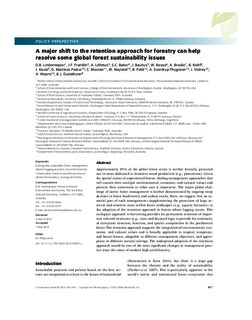| dc.contributor.author | Lindenmayer, D.B. | |
| dc.contributor.author | Franklin, J.F. | |
| dc.contributor.author | Lõhmus, A. | |
| dc.contributor.author | Baker, S.C. | |
| dc.contributor.author | Bauhus, J. | |
| dc.contributor.author | Beese, W. | |
| dc.contributor.author | Brodie, A. | |
| dc.contributor.author | Kiehl, B. | |
| dc.contributor.author | Kouki, J. | |
| dc.contributor.author | Pastur, G. Martínez | |
| dc.contributor.author | Messier, C. | |
| dc.contributor.author | Neyland, M. | |
| dc.contributor.author | Palik, B. | |
| dc.contributor.author | Sverdrup-Thygeson, Anne | |
| dc.contributor.author | Volney, J. | |
| dc.contributor.author | Wayne, A. | |
| dc.contributor.author | Gustafsson, L. | |
| dc.date.accessioned | 2018-07-26T18:41:17Z | |
| dc.date.available | 2018-07-26T18:41:17Z | |
| dc.date.created | 2012-11-14T12:18:37Z | |
| dc.date.issued | 2012 | |
| dc.identifier.citation | Conservation Letters. 2012, 5 (6), 421-431. | nb_NO |
| dc.identifier.issn | 1755-263X | |
| dc.identifier.uri | http://hdl.handle.net/11250/2506616 | |
| dc.description.abstract | Approximately 85% of the global forest estate is neither formally protected nor in areas dedicated to intensive wood production (e.g., plantations). Given the spatial extent of unprotected forests, finding management approaches that will sustain their multiple environmental, economic, and cultural values and prevent their conversion to other uses is imperative. The major global challenge of native forest management is further demonstrated by ongoing steep declines in forest biodiversity and carbon stocks. Here, we suggest that an essential part of such management—supplementing the protection of large reserves and sensitive areas within forest landscapes (e.g., aquatic features)—is the adoption of the retention approach in forests where logging occurs. This ecological approach to harvesting provides for permanent retention of important selected structures (e.g., trees and decayed logs) to provide for continuity of ecosystem structure, function, and species composition in the postharvest forest. The retention approach supports the integration of environmental, economic, and cultural values and is broadly applicable to tropical, temperate, and boreal forests, adaptable to different management objectives, and appropriate in different societal settings. The widespread adoption of the retention approach would be one of the most significant changes in management practice since the onset of modern high-yield forestry. Ecologically sustainable forest management; altered logging practices; forest biodiversity conservation; forest ecosystem processes; altered forest policy; ecological forestry. | nb_NO |
| dc.description.abstract | A major shift to the retention approach for forestry can help resolve some global forest sustainability issues | nb_NO |
| dc.language.iso | eng | nb_NO |
| dc.rights | Attribution-NonCommercial-NoDerivatives 4.0 Internasjonal | * |
| dc.rights.uri | http://creativecommons.org/licenses/by-nc-nd/4.0/deed.no | * |
| dc.title | A major shift to the retention approach for forestry can help resolve some global forest sustainability issues | nb_NO |
| dc.title.alternative | A major shift to the retention approach for forestry can help resolve some global forest sustainability issues | nb_NO |
| dc.type | Journal article | nb_NO |
| dc.type | Peer reviewed | nb_NO |
| dc.description.version | publishedVersion | nb_NO |
| dc.source.pagenumber | 421-431 | nb_NO |
| dc.source.volume | 5 | nb_NO |
| dc.source.journal | Conservation Letters | nb_NO |
| dc.source.issue | 6 | nb_NO |
| dc.identifier.doi | 10.1111/j.1755-263X.2012.00257.x | |
| dc.identifier.cristin | 962093 | |
| cristin.unitcode | 192,14,0,0 | |
| cristin.unitname | Miljøvitenskap og naturforvaltning | |
| cristin.ispublished | true | |
| cristin.fulltext | original | |
| cristin.qualitycode | 1 | |

